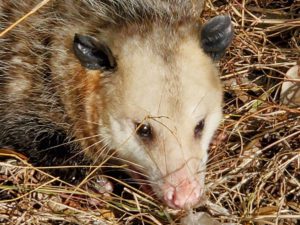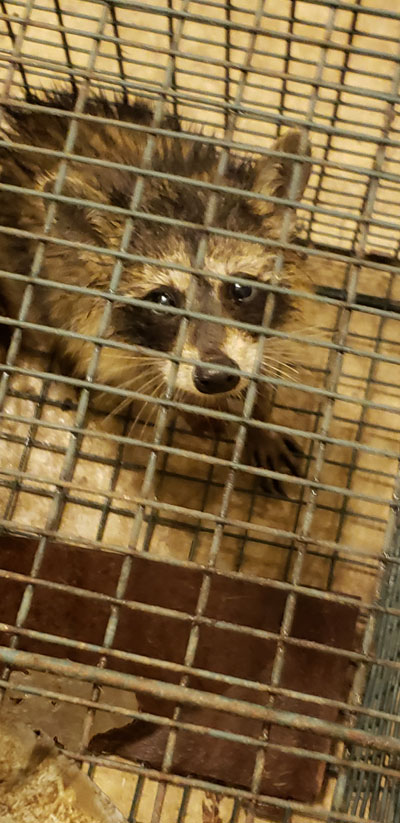Photo: The first of 13 raccoons (Procyon lotor), a youngster from this year, we’ve live-trapped since November 7th.
Beginning around November 1st of this year, our greenhouses began to show signs of a raccoon (Procyon lotor) invasion. This often happens in the Fall when the mature raccoon population reaches its annual peak as young raccoons become self-sufficient and their mothers begin to think about the upcoming mating season.
Raccoons offer us a year-round problem. They are very adept at finding or creating entrances into our greenhouses, which provide them with water and food and lots of opportunities for mischief. The first sign is our dogs (German Shepherds Oso and Maya and rescue mutt Sunshine) eagerly dashing into the greenhouses during late evening and early morning greenhouse checks in hopes of catching a raccoon. Other signs are nets, plastic sorting jars, buckets, etc. tipped over, knocked down, and strewn about. The occasional headless fish on a walkway or on the water pipes is also a clue. For some reason raccoons eat the heads and leave the rest of the fish, much like our local skunks (Mephitis mephitis) who eat only the heads of chickens they kill.
Possums (Didelphis virginiana) also enter the greenhouses on occasion but cause much less damage than the more intelligent and dexterous raccoons. The photo below is of the most recent possum trapped, an adult male. When I tried to release him, he stubbornly held onto the trap. I finally dislodged him and dumped him unceremoniously on the ground. He didn’t play possum, but neither did he run away. I suppose he eventually left.

So, what about the above title? First, that is the number of raccoons and possums we’ve live trapped to date (December 15th) since November 7th. We have three raccoon-sized Havahart live traps. These traps don’t harm the varmints except for the trauma of being caged. Since we bait with high protein fish pellets, the varmints get a meal out of the ordeal. Beginning the evening of November 6th, I’ve set one, two, or three of them. I only set them when I will have time the next morning to transport and relocate pests, as a result they are set only once every two to three nights. Eight of the raccoons trapped were this year’s kits and five were mature adults. Two of the possums were mature and one a youngster from this year. I will continue to trap and relocate until there are no more signs of greenhouse intrusions.
Now, what about the parenthetical “and Coonhound Paralysis?” If you’ve never heard of it before, join the club; until about a week ago neither had I. Susie (wife and business manager) and I were in town (Goliad) at a Chamber of Commerce function. Susie is on the Chamber board. While talking with a friend, I mentioned the number of raccoons and possums we’d recently trapped. She, the friend, asked me if I knew of coondog paralysis. I hadn’t. She described the ordeal they went through with one of their dogs that had been diagnosed with it. The dog took months to recover from almost total paralysis. Another friend turned to me and said, “You should blog about this.”
Upon getting home, I went online to research the disease. I found it under name Coonhound Paralysis (technically: Acute canine idiopathic polyradiculoneuritis (ACIP)). One of the sites covering it was PetMd (https://www.petmd.com/dog/conditions/neurological/c_dg_coonhound_paralysis). Here’s a description of the disease from that site:
“Acute canine idiopathic polyradiculoneuritis (ACIP) is a creeping paralysis due to acute inflammation of the nerves. This disease is often seen in dogs that live in North America as well as in those areas where raccoons are present but overall incidence is quite low. Any breed is at risk, but dogs that regularly come into contact with raccoons are at increased risk, such as hunting dogs and dogs that live in rural or wooded areas.”
And its possible cause:
“Besides the known connection that has been made with affected dogs coming into contact with raccoon saliva, the exact cause of ACIP is still unknown. Viral or bacterial infections are suspected to be responsible, and because of the correlation with the nervous system and neural pathways, an autoimmune link is being researched. It is thought that white blood cells may be attacking the nerves.”
For information about symptoms and treatments, see the full article at the link above.
Reading the article got me to thinking about an earlier German Shepherd we had, Bear (he’s the namesake for Oso, which is bear in Spanish). Bear came from Santa Fe, New Mexico with us in 2000. He lived to a ripe old age for German Shepherds of 12 years. The last year of his life he developed mild hip paralysis; but not hip dysplasia which large dog breeds are subject to. That is a problem of loose hip sockets. Bear didn’t have that. Our vet couldn’t find a cause, but suspected an auto-immune problem and prescribed steroids. He said the steroids would eventually kill Bear through kidney damage, but if they worked, Bear would recover full use of his hind legs. The steroids worked. One of Bear’s daily pleasures was barking at and chasing our horses, Blondie and Princess. He did that the morning before we had to put him down due to kidney failure. He lived a full, energetic life and only suffered the last day as his kidneys finally failed. I wonder if he had Coonhound Paralysis. Bear killed raccoons whenever he could catch them, which was several times a year, so he could have been exposed.
In any event, I plan to limit our dogs’ contact with raccoons in the future.


Leave a Reply